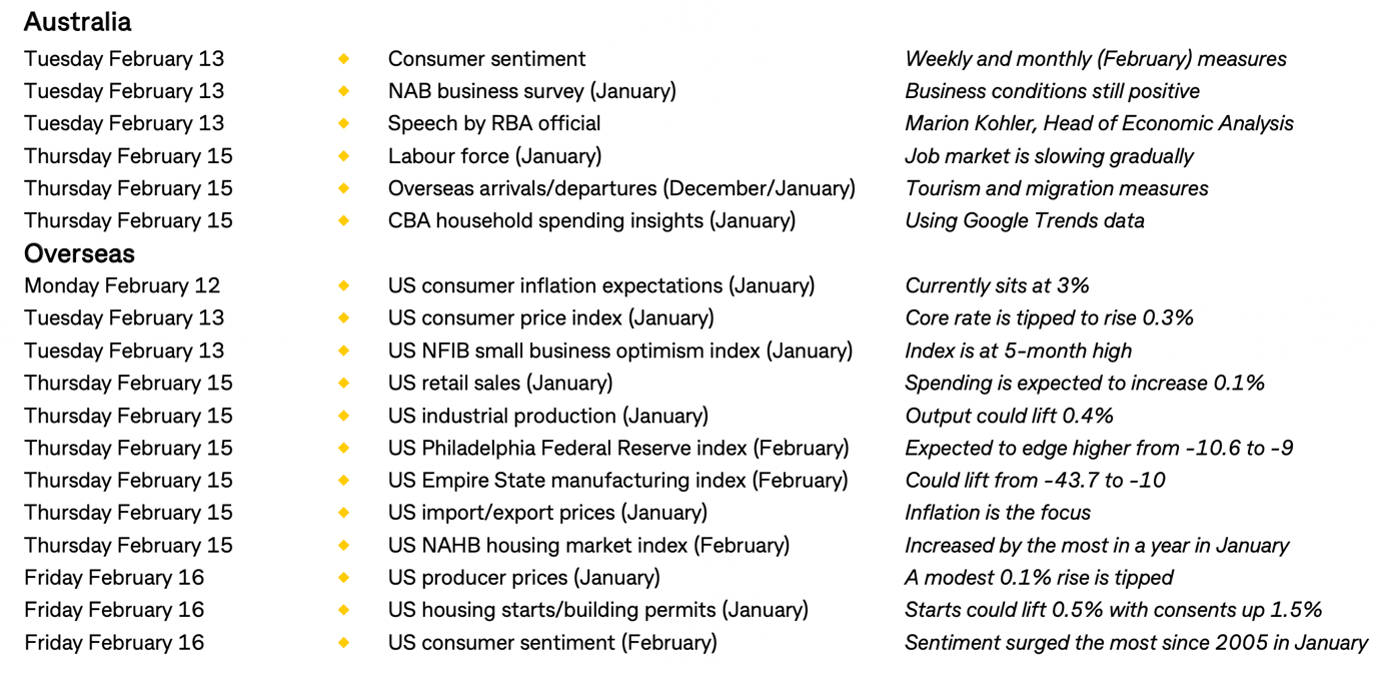
With the Dow Jones and S&P 500 at all-time highs and the Nasdaq flirting with it overnight, it’s pretty understandable that experts are warning us to be ready for a pullback. I’ve been expecting it and have been referring to it as likely but when it happens, I will pull out my old “this is a buying opportunity” line.
Of course, it will be our job to pick what’s worth buying but the reason why I retain confidence in stocks for 2024 is simply because the economic and corporate health behind stocks is looking good — surprisingly good!
This week we saw how well US companies are going, with 70% of US S&P 500 companies reporting December quarter earnings, with 79.5% coming in better than expected, which is above the norm of 76%.
Underpinning this great take on US profits is an economy that (at this stage) looks like it has emerged out of the Covid-lockdown era with near super economic powers “beyond those of mortal” economies!
Old Superman fans might recall those words, but they do seem appropriate after we saw better-than-expected jobs numbers in the US last week, which followed hot on the heels of better inflation indicators than tipped by top US economists.
This week the Yanks get an important CPI reading and Wall Street will be hanging off that number because if it suggests that inflation’s drop is stalling, then the conclusion will be that the Fed will delay any rate cuts, which was the most recent takeout from its boss Jerome Powell last week.
In fact, Powell starred on the US TV show 60 Minutes, and on his inflation fight bluntly said: “The job is not done. And we’re very much committed to making sure that we fully restore price stability for the benefit of the public”. When asked why not cut rates now, he followed up with this: “Well, we have a strong economy. Growth is going on at a solid pace. The labor market is strong: 3.7% unemployment. With the economy strong like that, we feel like we can approach the question of when to begin to reduce interest rates carefully. And we, you know, want to see more evidence that inflation is moving sustainably down to 2%. We have some confidence in that. Our confidence is rising. We just want some more confidence before we take that very important step of beginning to cut interest rates”.
This is why I’m inferring that at the moment the US looks like a super economy but for the past few years we have been excessively committed to the big data drops. And ahead of next week’s CPI, Wall Street liked other inflation news overnight.
On that subject, CNBC reported: “A revision lower in December’s consumer price index also helped sentiment. The government adjusted the figure to a 0.2% increase, down from a 0.3% increase initially reported.”
Not surprisingly, the best bellwether indicator that US interest rates will get cut some time in the US — the yields in bond markets — fell on the news and sets up next week’s CPI as huge for the stock market — both there and here.
By the way, ahead of the close and driven by the big tech companies, the Nasdaq was up over 1%, which reinforces my optimism for stocks this year, even if a pullback inevitably happens.
UBS is on my side, with Jason Draho, head of asset allocation for the Americas, arguing that it’s “Goldilocks for equities, at least for now, with more market swings,” ahead. The UBS team expects that continuing economic growth, ongoing disinflation and rate cuts down the line will support equities. Interestingly, expert stocks watcher Draho told us that, even though “Much of this good news is priced in and valuations look relatively expensive, that doesn’t prevent more upside”.
And Draho educated us with the insight that even though the S&P 500 is expensive relative to historical levels, he believes valuations are a “poor predictor of market reversals”. He laboured a point I’ve been making about the surge in the S&P 500 that, outside of large-cap growth from the likes of Microsoft, Facebook and some other tech shares, valuations for most companies in the S&P 500 remain relatively cheap.
Eventually, these will play catch-up and help indexes go higher over this year and smarties will be looking for individual good company plays.
To the local story and retail stocks did better than expected this week, as the S&P/ASX 200 lost 54.6 points (or 0.71%) to 7644.80.
Nick Scali was up an unbelievable 22.65% to $15.11 and Myer put on 9.56% to 74 cents. Elsewhere, Lovisa had a nice rebound, which Ben Griffiths of Eli Griffiths tipped on my TV show a couple of weeks ago. The affordable jewellery business was up 5.91% for the week to $24.37.
On the bad news front, uranium investors had a rough week. The AFR reported that “uranium stocks reversed weeks of gains, after major Canadian miner Cameco revealed plans to expand production overnight. Boss Energy tumbled 12.7 per cent to $5.23, with Paladin losing 7 per cent to $1.32.”
Meanwhile, Cochlear (COH) had a good week, up 4.34% to $322.73 after it reported a better profit outlook. And the AFR said “Charter Hall Long WALE REIT is aiming to divest more than $500 million worth of commercial property to reduce its debt load, after portfolio write-downs pushed its gearing level higher and sent its 2024 interim earnings to a $258.4 million statutory loss”.
The stock rose nearly 3% for the week to $3.81, which implies the market thinks the company is taking the right actions to bolster its bottom line going forward.
Finally, the ZIP believers had a nice week, with a 32.85% rise to 91 cents after links to its US rival Affirm got the market excited. But there’s no firm news, so be careful. Falling interest rates will escalate merger and takeover activity, so lots of beaten up but OK companies could be big stars this year. We will try and find them!
What I like
- The RBA holding rates and not talking up rate rises. It was a balanced and sensible monetary statement.
- The RBA has downwardly revised its end of 2024 inflation forecast from 3.5% to 3.2%.
- This from Shane Oliver on rate cuts: “Three rate cuts this year will still leave mortgage rates well up on their 2021-22 lows. The money market is now pricing in an 60% chance of a cut by June and two cuts by year end.”
- Retail sales per person fell 0.3% in the quarter and is down 3.5% year-on-year and shows rate rises are working.
- Chinese shares gained on news of more market support measures and stimulus.
- Experts think the bear market in Chinese shares may be nearing an end. After having nearly halved in value since its October 2021 peak, Chinese shares are now undervalued (with a forward PE just below 10x), oversold and under-loved and may be due at least a further bounce if there’s more news of Government support.
- Fed Chair Powell reiterated his wariness about cutting rates too early but continued to foreshadow the Fed cutting rates this year. This was sensible for an over-excited stock market.
- The services conditions ISM in the US rose solidly in Januarysuggesting strength and jobless claims fell.
What I didn’t like
- The $A fell as the $US rose on the back of the strong payroll report. We don’t want the US to grow too strongly and rekindle fears of rate cuts being pushed out further into late 2024.
- Eurozone retail sales fell in Decemberand are down on a year ago, highlighting its ongoing weakness relative to the US. Producer prices fell further in March and are down 10.6% on a year ago pointing to a further fall in consumer price inflation.
- Chinese deflation continued in Januarywith producer prices down 2.5% year-on-year and consumer prices down 0.8% year-on-year. Core CPI inflation slowed further to 0.4% year-on-year.
The biggie for next week
As I’ve implied, the big focus for markets will be on the CPI inflation data for January due out on Tuesday, US time, which is expected to fall to 0.2% on a monthly basis, taking annual inflation down to 2.9% year-on-year from 3.4%, with core inflation falling to 3.7% year-on-year from 3.9%.
A better-than-expected number will excite Wall Street and then our market, but a disappointing figure could kickstart that pullback that many are predicting.
Switzer This Week
Switzer Investing TV
- Boom Doom Zoom: Paul Rickard and Peter Switzer answers your questions on LTR, RMD, ISO & more
- SwitzerTV Investing:The stocks that could surge in 2024!
- The Switzer Show Podcast: Everything you wanted to know about Superannuation but was too afraid to ask.
Switzer Report
- Two stocks specialling in the remediation of damaged buildings
- “HOT” stock: Woodside Energy (WDS)
- Questions of the Week
- More reasons to invest, but in what?
- Portfolios show solid gains as market hits a record high
- HOT stock: Corporate Travel Management Ltd (CTD)
- Two cheap mining services opportunities
- Buy, Hold, Sell — What the Brokers Say
Switzer Daily
- We’re being ripped off, so where’s Albo or the ACCC?
- Take me to lunch but don’t call me out of hours!
- RBA boss didn’t promise rate cuts but they’re coming
- Big day ahead for Aussies with cost of living problems
- Will our new & improved RBA board hint at rate cuts on their way?
The Week Ahead

Top Stocks — how they fared

Most Shorted Stocks

ASIC releases data daily on the major short positions in the market. These are the stocks with the highest proportion of their ordinary shares that have been sold short, which could suggest investors are expecting the price to come down. The table shows how this has changed compared to the week before
Chart of the Week
70% of US S&P 500 companies have now reported December quarter earnings with 79.5% coming in better than expected, which is above the norm of 76%. So far earnings growth for the quarter is running around +8% on a year to year basis, which is well up from consensus expectations for 4.3% growth at the start of the reporting season.

Quote of the Week
AMP’s Shane Oliver, following the RBA decision and the Governor’s press conference: “We continue to see rates as having peaked, with rate cuts starting from around mid-year.”
( Shane has tipped three cuts by year’s end!)
Disclaimer
Important: This content has been prepared without taking account of the objectives, financial situation or needs of any particular individual. It does not constitute formal advice. Consider the appropriateness of the information in regards to your circumstances.

